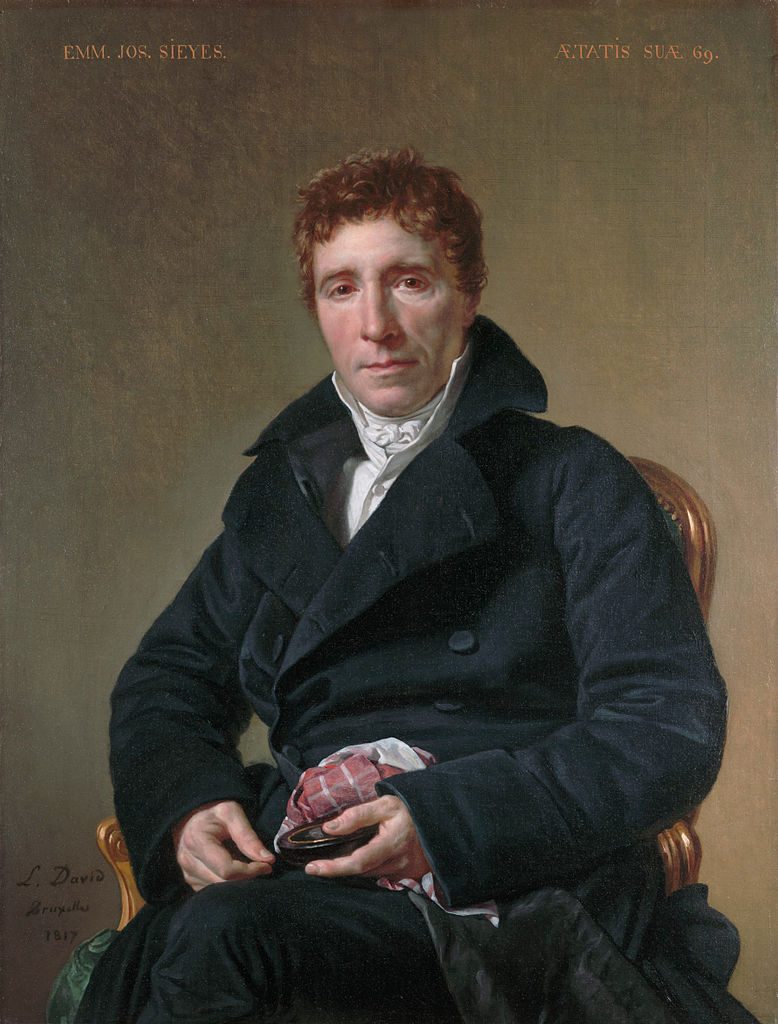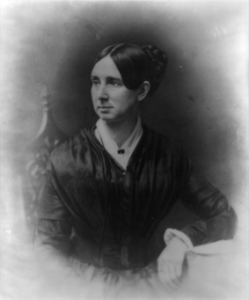Emmanuel Joseph Sieyès, also known as the Abbè Sieyès, was a major player of the French Revolution. During this period he challenged the ancien régime system of unequal representation in the Estates-General and fought against the traditional privileges held by the aristocracy and clergy. He believed that the members of the third estate were the true foundation of France and that they deserved to play a role in French politics equal to their importance. As a member of the clergy, and therefore of the first estate, he did not let his privileges influence him, and he worked hard to help the third estate rise to the level of its rightful stature.
In the eighteenth century, French society was divided into three traditional estates going back to the middle ages. Representatives from these three estates had traditionally met in something called an Estates-General, which met when the French king would call for it to meet. Once assembled, it would debate on topics and issues of importance to the realm, and give the king their opinion on a matter by voting by estate. However, last time the Estates-General had been called together was 1614. When they were called upon to meet again, in 1789, they did so in the wake of a major shift in understanding the nature of representation. Traditionally, the first estate was made up of members of the clergy, the second estate was made up of the nobility, and the third estate was made up of commoners, or everybody who was not of the clergy or nobility. They were all ruled by a king, who was considered a part of no estate. Traditionally, each estate had one vote when voting at the Estates-General; thus, the nobility and clergy each had one vote, and they often voted together, while the third estate, which was made up of more than 95 percent of the population of France, only had one vote as well. This was a serious problem because the representatives of 95% of France could be outvoted by the 5% minority of the nobility and clergy. Before they met in 1789, this had not been seen as a problem, because the concept of equal or proportional representation only arose in the wake of the French Enlightenment, becoming manifest in the American Revolution. Previously, the Estates-General only met during times of conflict and crisis. During these times, the peasants were the ones most affected, whether with taxes or extreme poverty, and they never had adequate representation to defend their situation.1 But in 1789, as the Estates-General was being called together, with this change in sentiment about representation circulating in intellectual circles, how would that sentiment become manifest as it had in the motto of the American Revolution–“no taxation without representation?” The man who made it manifest was Abbè Sieyès.
Emmanuel Joseph Sieyès was born on May 3, 1748, and one would not have thought that he was destined to lead an important, high profile life. He was the son of a postmaster and notary, and while he did not live extravagantly, he lived fairly comfortably. As a child, Sieyès had a private tutor, and then he went to college at the Jesuits’ College at Fréjus where his teachers adored him and thought that he was extremely smart. This was important for him, because some middle-class students were regularly recruited to be trained for the clergy, which could mean a social improvement to their current status. When he was seventeen, he joined the Seminary of Saint-Suplice in Paris and made a good reputation for himself. While he was there, he broadened his knowledge and started learning about things that would become his passion later on in life. He showed an interest in the writings of the French Enlightenment, which would influence his decisions and passions. As a clergyman, he was very popular and moved up its career ladder quite quickly. In 1773, by the time he was twenty-five, he was ordained a priest. Quickly after that he moved up to secretary to the Bishop of Treguier, thanks to connections who knew the Bishop of Fréjus. He stayed an administrative priest after this, but worked on other matters that were closer to his heart.2
During his career as a priest, he wrote several works. Two of his works were anonymous and the third is now considered theory by historians. Before he became well known, he wrote the “Letter to the Physiocrats On Their Political and Moral System.” This work looked at the political side of economic activity that was beneficial to the nation as a whole. With this kind of thinking in mind, Sieyès joined the provincial assembly of Orleans in 1787.3
In 1788, the King of France, Louis XVI, was facing serious financial problems, and he called the meeting of the Estates-General for May 1, 1789. As mentioned earlier, the group had not met since 1614, and so a lot of people were uncertain about the role that this group would have in current French politics. However, it became clear even before the Estates-General met that the first two estates would vote against any of the reforms that the third estate might suggest, especially if those reforms infringed upon their traditional rights and privileges; and this caused a lot of debate and frustration.4
It was during the time between when King Louis XVI called the meeting and when the meeting actually took place that Sieyès published his first pamphlet called, “Essai sur les privileges” or “Essay on privileges.” Sieyès argued that privilege went against natural law, reason, and community. Sieyès did not think that the nobility deserved to have special privileges because it did nothing to earn them. He showed how the nobility were like parasites, just taking advantage of French society and reaping the benefits from the work of others. He argued that the current division of society based on estate privileges was not conducive to a well-functioning society. Shockingly, he stated that the nobility had no place in their modern society that was progressing.5

In December of 1788, months before the meeting of the Estates-General, he wrote another pamphlet that questioned the constitution of the Estates-General itself. He argued for the importance of making a national assembly to better represent the majority of the population that created the wealth of the nation. Both of these pamphlets built up and led to his third and most famous pamphlet, “Qu’est-ce que le tiers état?” or “What is the third estate?” This was arguably the most influential pamphlet of its time. The pamphlet argued for a drastic change in political power in the French legislative system. It challenged the inequality of power in the Estates-General and questioned why the largest and most hardworking part of society had the least amount of power, and why they had only one vote compared to the combined votes of the clergy and nobility, who made up only three percent of the entire French population. Traditionally, each of the three estates were to debate among themselves on some important issue and then take a collective vote that would be their final estate vote. Sieyès suggested a method that would replace the vote by estate with a simple head count vote of all representatives of the three estates taken together. This pamphlet was radical for the time, because it questioned the right and legitimacy of the first two estates to represent the nation of France at all.6 Sieyès asked three simple questions that put the entire arrangement of the ancien régime under indictment:
What is the third estate?–Everything.
What, until now, has it been in the existing political order?–Nothing.
What does it want to be?–Something.7
By the time the Estates-General met in May, Sieyès was well-known and well-liked by the general population, even though he was a member of the first estate of the clergy. His theories were at first viewed very favorably by reformers and it earned him a seat at the Estates-General as a representative of the third estate, where people took him seriously and listened to what he had to say.8 King Louis XVI had wanted to tax the nobility, who had always been exempt from paying taxes. Traditionally, taxes were first raised on the peasants, but on this occasion, the peasants simply could not bear to pay more. The king had to call the Estates-General together because the two privileged estates did not want to surrender their tax exemptions. Much to their disappointment, the third estate, led by reformers such as Sieyès, looked to the example that America had provided against the British. Thanks to Sieyès and his pamphlet What is the third estate?, members of the third estate asserted their answer to Sieyès’ third question: What does [the third estate] want to be? Something. They broke away from the Estates-General and formed the National Assembly to be the representative body of France, to vote on matters that concerned the nation of France, and to establish a constitution that would bind all members of society into a social contract, including the king.9 In essence, they turned the absolutist kingdom of France and its subjects into the nation of France governed by a constitutional monarch and its citizens.
Emmanuel Sieyès strongly influenced his time by being bold enough to speak out against the abuse of the upper class on the lower class. Even though he could have just stayed silent and enjoy the privileges of his estate, instead he saw the injustices that so many of his fellow countrymen were facing, and he took his stand against it.
- Encyclopædia Britannica, 2014, s.v. “Estates-General.” ↵
- Salem Press Biographical Encyclopedia, 2016, “Emmanuel-Joseph Sieyès,” by Irwin Halfond. ↵
- Salem Press Biographical Encyclopedia, 2016, “Emmanuel-Joseph Sieyès,” by Irwin Halfond. ↵
- Encyclopædia Britannica, 2014, s.v. “Estates-General.” ↵
- Salem Press Biographical Encyclopedia, 2016, “Emmanuel-Joseph Sieyès,” by Irwin Halfond. ↵
- Emmanuel-Joseph Sieyès, What Is the Third Estate? ed. Nicholas Snead (Gale, Cengage Learning, 2013), 348. ↵
- Emmanuel Joseph Sieyès, Qu’est-Ce Que Le Tiers État. ↵
- Emmanuel-Joseph Sieyès, What Is the Third Estate? ed. Nicholas Snead (Gale, Cengage Learning, 2013), 350-351. ↵
- Jerry Bentley, Herbert Ziegler, and Heather Streets-Salter, Traditions & Encounters, 4th ed., vol. 2 (New York: McGraw Hill Education, 2015), 474. ↵



50 comments
David Castaneda Picon
This is a very interesting story and a greatly descriptive article. I has never heard about this French revolutionary character before until this semester in my SMC 1301 class. I love that the author did an outstanding job explaining who Emmanuel Joseph Sieyés is and what he represented and defended.
Amanda Shoemaker
This article really put a spotlight on Abbè Sieyès and his role in the French Revolution. The fact that the third estate held a majority of the population and yet had little to no impact on the way things were run showed that a change was needed. Sieyès’ work was a real pivotal point for the revolution and his writings really made people realize how much change was needed.
Sara Guerrero
I’ve recenlty learned about Emmanuel Seyes and what he did for the third estate in France and he truly is someone to be recognized since he brought awareness about the third estate being the backbone of France. I had no idea that he was a member of the first estate clergy, but I think it is more interesting that a man of his status would take into consideration the thoughts and views of the third estate, since they were taken advantage of. What a great article and I really taught me more of who Seyes was personally.
Giselle Garcia
Abbe Sieyes was very brave at that time to publish a pamphlet that objected to the Estates General representation. Even though Sieyes was a part of the First Estate, he still believed in the power of the Third Estate and believed they needed to be represented fairly since they made up the majority of France. I especially liked his argument for the Third Estate wanting to be something, which prompted the start of the French Revolution.
Arsema Abera
I am shocked that the French actually practiced voting, well at least some sort of voting, but it turns out the minority right and majority rule was yet something they were being ignorant at, and it seemed like the third estate was a joke. As for Emmanuel Sieyès, he was a very smart and influential person. His role in the revolution is really big and He played his part and made sure that the first and second estates got the message loud and clear.
Lesley Martinez
This is a well-written and interesting article! The life of Emmanuel Joseph Sieyes introduced new ideas about the lawfulness of the three traditions estates. It’s especially interesting that the concept of equal or proportional representation did not play a vital role until the French Enlightenment. I’m shocked that 175 years passed without an Estates-Meeting. Nonetheless, Sieyes was willing to raise awareness about the inequalities through his pamphlets, even though he was part of the third estate. Great article!
Antonio Holverstott
As I was reading this article, I did share some objections to the voting system of the Estates of Imperial France. Even though the system itself was not inherently objectionable since every group had the same amount of votes within the legislature, the system was taken advantage of by members of the noble and clerical estates. However, even though he strived to attack the inequality of the system, in the end, he also shifted the foot of oppression from the nobles and clergy to the foot of the Third Estate. Reasons for this included calling all nobles and clergy as immoral and the Third Estate as righteous, even though both sides held corrupt persons. In addition, instead of creating equality between the nobility and clergy and commoners, the commoners took over the entire assembly.
Zachary Kobs
Excellent job providing context to who Emmanuel Joseph Sieyès is and what he stood for and how he got to be there! I have never heard about him prior to this reading but it is clear to see that he was a great man. I am thankful that he stood out against injustices because an “injustice anywhere is a threat to justice everywhere.”-MLK.
Samuel Vega
I think the author did a good job of telling the story of Abbe Sieyes first and then showed how he influenced the formation of a new French government. The article gives a great description on the three Estates of France and how the clergy and nobility for years controlled the third estate or the commoners. Abbe Sieyes became the voice for 95% of the nation. The commoners were fed up with the taxation and starvation that was prominent in France. . This sparks the French Revolution.
Nicole Ortiz
I had not heard about Abbe Sieyes and his role in the French Revolution until this year in my SMC 1301 class. It was so interesting to learn about him and despite being in a different estate than the 3rd one, he still wanted to try and make a difference for those dealing with injustices in the third estate. If it wasn’t for Sieyes, the French would have never been able to start the chain reaction to change the French government and authority